Low Potassium Vegetables

For those diagnosed with chronic kidney disease (CKD) the shock of being diagnosed is often accompanied by dietary guidelines restricting the intake of potassium and other electrolytes. The next realization is that almost all vegetables contain some amount of potassium.
While this is true, there are a few vegetables that are lower in potassium, and the amount of potassium in vegetables can be further reduced by soaking the vegetables in water before cooking, in a process called leaching. This works well for vegetables that will be eaten raw. Cooked vegetables should be boiled, and the water they are boiled in should be discarded.
While the daily value (DV) for potassium is 4700 milligrams (mg), a vegetable can be considered to be "low potassium" if it has less than 200mg of potassium per serving (please watch portion sizes). (2) The list of vegetables below serves as a suggestion of low potassium vegetables for your diet and is for informational purposes only. Please work with your primary care provider to establish a proper diet.
Note: Please use the percent daily value in this article only as a guide to compare foods and not as a target!
The amount of potassium in vegetables may vary based on the soil and conditions in which they are grown. The numbers below can be considered averages across the U.S. To be safe, incorporate new vegetables into your diet slowly and in small quantities.
Low potassium vegetables include cilantro, alfalfa sprouts, lettuce, arugula, kale, Napa cabbage, leeks, spaghetti squash, sweet onions, eggplant, and more. For more low potassium vegetable ideas, see the complete ranking of over 200 vegetables low in potassium.
Most vegetables are low in calories, and so should be eaten with other low potassium foods.
List of Low Potassium Vegetables
 1 Cilantro
1 Cilantro| Potassium per 1/4 Cup | Potassium per 100g | Potassium per 200 Calories |
|---|---|---|
| 21mg (0% DV) | 521mg (11% DV) | 4530mg (96% DV) |
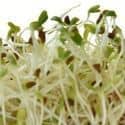 2 Alfalfa Sprouts
2 Alfalfa Sprouts| Potassium per Cup Raw | Potassium per 100g | Potassium per 200 Calories |
|---|---|---|
| 26mg (1% DV) | 79mg (2% DV) | 687mg (15% DV) |
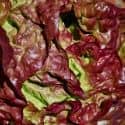 3 Lettuce
3 Lettuce| Potassium per Cup Shredded | Potassium per 100g | Potassium per 200 Calories |
|---|---|---|
| 52mg (1% DV) | 187mg (4% DV) | 2877mg (61% DV) |
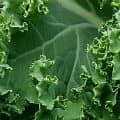 4 Kale
4 Kale| Potassium per Cup Fresh | Potassium per 100g | Potassium per 200 Calories |
|---|---|---|
| 56mg (1% DV) | 348mg (7% DV) | 1989mg (42% DV) |
 5 Arugula
5 Arugula| Potassium per Cup Fresh | Potassium per 100g | Potassium per 200 Calories |
|---|---|---|
| 74mg (2% DV) | 369mg (8% DV) | 2952mg (63% DV) |
 6 Napa Cabbage
6 Napa Cabbage| Potassium per Cup Cooked | Potassium per 100g | Potassium per 200 Calories |
|---|---|---|
| 95mg (2% DV) | 87mg (2% DV) | 1450mg (31% DV) |
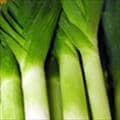 7 Leeks
7 Leeks| Potassium per Leek Cooked | Potassium per 100g | Potassium per 200 Calories |
|---|---|---|
| 108mg (2% DV) | 87mg (2% DV) | 561mg (12% DV) |
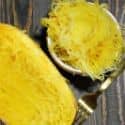 8 Spaghetti Squash
8 Spaghetti Squash| Potassium per Cup Cooked | Potassium per 100g | Potassium per 200 Calories |
|---|---|---|
| 109mg (2% DV) | 108mg (2% DV) | 697mg (15% DV) |
 9 Onions
9 Onions| Potassium per Cup Cooked | Potassium per 100g | Potassium per 200 Calories |
|---|---|---|
| 116mg (2% DV) | 133mg (3% DV) | 216mg (5% DV) |
 10 Eggplant
10 Eggplant| Potassium per Cup Cooked | Potassium per 100g | Potassium per 200 Calories |
|---|---|---|
| 122mg (3% DV) | 123mg (3% DV) | 703mg (15% DV) |
 11 Cabbage
11 Cabbage| Potassium per Cup Raw | Potassium per 100g | Potassium per 200 Calories |
|---|---|---|
| 151mg (3% DV) | 170mg (4% DV) | 1360mg (29% DV) |
 12 Green Bell Peppers
12 Green Bell Peppers| Potassium per Cup Cooked | Potassium per 100g | Potassium per 200 Calories |
|---|---|---|
| 154mg (3% DV) | 134mg (3% DV) | 231mg (5% DV) |
 13 Peeled Cucumber
13 Peeled Cucumber| Potassium per Cup Sliced | Potassium per 100g | Potassium per 200 Calories |
|---|---|---|
| 162mg (3% DV) | 136mg (3% DV) | 2720mg (58% DV) |
 14 Cauliflower
14 Cauliflower| Potassium per Cup Cooked | Potassium per 100g | Potassium per 200 Calories |
|---|---|---|
| 176mg (4% DV) | 142mg (3% DV) | 1235mg (26% DV) |
 15 Celery
15 Celery| Potassium per Cup Raw | Potassium per 100g | Potassium per 200 Calories |
|---|---|---|
| 263mg (6% DV) | 260mg (6% DV) | 3714mg (79% DV) |
About the Data
Data for the curated food lists comes from the USDA Food Data Central Repository.
You can check our data against the USDA by clicking the (Source) link at the bottom of each food listing.
Note: When checking data please be sure the serving sizes are the same. In the rare case you find any difference, please contact us and we will fix it right away.
About Nutrient Targets
Setting targets can provide a guide to healthy eating.
Some of the most popular targets include:- Daily Value (%DV) - The daily value (%DV) is a general guideline for consumption that will prevent deficiency of a particular nutrient in most people. The %DV refers to the percentage of an amount that's found in a single serving of a food. It also accounts for absorption factors. It is set by the U.S. FDA.
- Recommended Dietary Allowance (%RDA) - The RDA sets an average daily dietary intake level that is sufficient to meet the nutrient requirements of nearly all (97.5%) healthy individuals. It's more specific than the daily value, and varies by age and gender. The RDA is set by the US National Instutites of Health.
- Reference Dietary Intake (%RDI) -The reference dietary intake is similar to the recommended daily allowance, but is specific to age and gender. The RDI for amino acids is set by the U.N. World Health Organization.
- Adequate Intake (%AI) - This value is primarily used in reference to omega-3 and omega-6 fats. The Adequate Intake is set by the U.S. Institute of Medicine. Because there is less evidence to determine the ideal targets for consumption of these nutrients, the specific amount is considered to be less reliable. Using the term Adequate Intake, rather than one of the other terms, helps to emphasize that the ideal intake of that particular nutrient has not yet been scientifically determined.
See the Guide to Recommended Daily Intakes for more information.
Want to set your own targets? Sign up for an account and set custom targets in the daily meal planner.From the Nutrient Ranking Tool
Use the ranking tool links below to select foods and create your own food list to share or print.
- Foods High in Potassium
- Foods Low in Potassium
- Vegetables High in Potassium
- Fruits High in Potassium
- Vegetarian Foods High in Potassium
- Nuts High in Potassium
- Grains High in Potassium
- Beans High in Potassium
- Dairy High in Potassium
- Breakfast Cereals High in Potassium
- Fast Foods High in Potassium
View more nutrients with the nutrient ranking tool, or see ratios with the nutrient ratio tool.
Related
Data Sources and References
Try the recipe nutrition calculator, or daily meal planner.
Create a free account to log and track foods.
